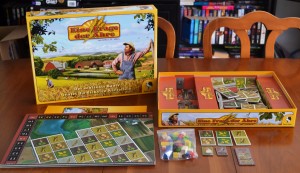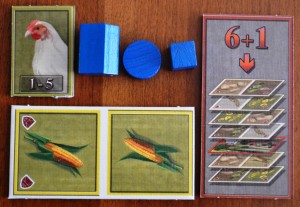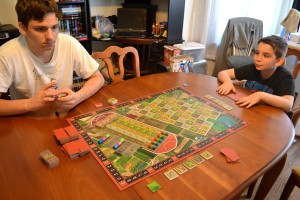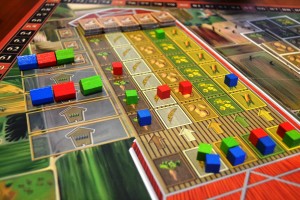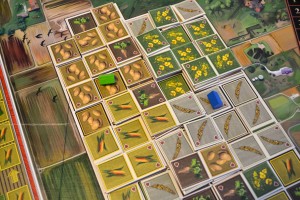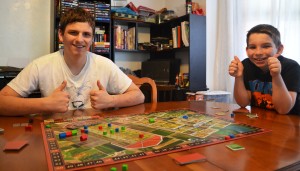“Heartland” is a three-dimensional tile-laying game that tasks players with earning the most victory points. In this particular instance, each player represents a settler that is trying to develop the best plot of land in Middle America during the early 1800’s (America’s “Heartland”). It’s worth noting that the box art of my copy is in German, but the rules include an English translation. The components themselves have no text on them, meaning that those who are thinking about buying this version will find it to be fully functional (even if you don’t speak German).
Components
Game Board – The board consists of a field for laying tiles and a barn for tracking a player’s individual barn points. A scoring track runs along the perimeter.
Land Tiles – Land tiles come in either small or large. Small tiles are square and contain one crop, whereas large tiles are rectangular and contain two crops. Players will be laying these on the game board’s field in order to score points.
Livestock Tiles – These square tiles serve as bonus points for endgame scoring. They are made up of cows, chickens, and pigs.
End of Game Tile & 6+1 Tile – The 6+1 tile is used to reserve six large land tiles for use at the end of the game. The end of game tile is mixed in with these six and when drawn, signals players to wrap things up.
Farms and Farm Cubes – Farm cubes are used to track a player’s progress along the barn scoring track. Once a certain amount of progress has been made along this track, farms are placed on the board by players to grant them bonus victory points. The black farm is given to the starting player, who keeps it for the duration of the game.
Victory Point Markers & Player Tile – The markers keep track of a player’s victory points along the track. The player tile can be flipped over to reveal the “100”, which reminds others during endgame scoring as to who lapped the score track.
Setup & Gameplay
The game’s setup process takes a little bit of doing, so I won’t recite what can be found in the manual (link below). To sum things up however, each player will get five small land tiles (one of each crop) as their face-up reserve and three large land tiles to form their secret hand. The board is populated appropriately (barns, barn cubes, livestock tiles, victory point markers, etc) and the starting player is given the black farm.
On a player’s turn, they’ll take four actions, in this order:
1. Place a Land Tile – The current player will place a tile from their hand, being careful to observe the placement rules. I won’t list all of them, but the most notable is that you can’t place a crop on top of a matching crop. You also can’t place a large land tile in a way that would result in it being on two different levels. You can, however, place a small tile from your reserve just before placing the large land tile to even out the level. Groups of like tiles that are adjacent to one another are called, “regions.”
2. Score Points – Most of the time, players will have a choice as to whether or not they want to score barn points or victory points. Those who want to score victory points look at the number of like crops in the region of the tile they just placed and move their victory point marker along the track. Those who want to score barn points look at the barn icons on only the crop itself and move that crop’s cube up the barn scoring track. After certain game conditions occur, barns can be placed on regions of the board to award players with bonus victory points on their turn. Once a cube has reached the end of a crop’s barn track, the player gets to take a livestock tile. Since there are two crops on a large land tile, players can opt to score both tiles as victory points, barn points, or one of each.
3. Assess Farms – As explained in step two, players earn bonus points for having farms out on the board. At this time, the current player moves their victory point token at a ratio of one point for every one crop in a barn’s region.
4. Draw Large Land Tile – The current player will draw a large land tile, bringing their hand size back up to three. If they still have three large land tiles (from playing only a small tile from their reserve), then they do not draw. The 6+1 stack is left alone until no more tiles are available from the pool.
Once the end of game tile is drawn, players continue taking turns until the starting player is reached (this ensures everyone has the same amount of turns). At this point, players flip up their livestock tiles (earned during step two) and move their victory point markers along the track appropriately. Whoever has the most points at the end of it all, wins!
The above is simply an overview of the game, but should give you an idea as to how it is played. You can check out the manual for more information here:
http://boardgamegeek.com/file/download/4h7j0a93ge/Eine_Frage_Aehre_Rules_English.pdf
The Review
In all honesty, the box art text was really the only thing that bothered me when my order arrived. Since the rules had an English translations and the components had no text on them, I was able to play the game without any hiccups. The components themselves are very colorful and of good quality. I was pleased with how much detail went into the artwork. The rules were laid out fairly well and I was really happy that there were illustrations for almost every step in a player’s turn. It made learning the game a whole lot easier. The box itself is a bit on the large side, which results in it not playing nice with others in my closet.
In terms of a learning curve, it’s not all that tough to play. The biggest hurdle was learning where I could and couldn’t place a tile, as well as how scoring worked. After a few turns however, we quickly got into the grove of things and were able to blow through the game rather quickly. Vinnie (12) had no trouble understanding the concepts once we got our feet wet. He recognized the tile-laying rules from “Sunrise City” (one of the first games I officially reviewed) and applied them here, which I was glad to see.
The inclusion of two different types of scoring tracks certainly makes things interesting. While it is true that in the end, only one of them really matters (the victory point track), investing in the barn scoring track may assist you in earning some extra victory points. Not only does the barn scoring track provide players with barns (which grant them bonus victory points per turn) but also livestock tiles (which grant them a one time bonus at the game’s end). This opens the door for a bit of strategy, as players can opt to concentrate heavily on one or the other, or mix it up with a bit of both. What players ultimately decide to do will change from game to game, based on the layout of the tiles.
Our game was an interesting one. Vinnie (12) pulled ahead in the very beginning and was up by about forty points through some lucky tile placement. Anthony (17) wasn’t too far behind, and I was dead last. Seeing that I wouldn’t get anywhere through tile placement, I passed up on victory points to earn barn points. I opted to block and mess up regions where I could to prevent the other two from gaining too much ground. I was the first to grab two cows and a barn, giving me a chance to catch up. Using my fillers (small tiles) to extend play time (so as not to draw large tiles), those points from my barn added up. In the end, I had netted around one hundred and fifty points with Vinnie and Anthony slightly behind. There was some tension between the two as they fought over land, but it wasn’t anything that would ruin the evening.
Overall, I was pleased with “Heartland” and how easy it was to pick up and play. The learning curve is light to moderate, making it a game that players of all ages can get behind. It will reward those more who enjoy thinking ahead and planning out their moves, but casual folks will be able to get by just as well. It’s a solid tile-laying game that is worth checking out, especially if you are new to the genre.
Final Verdict: 7/10

